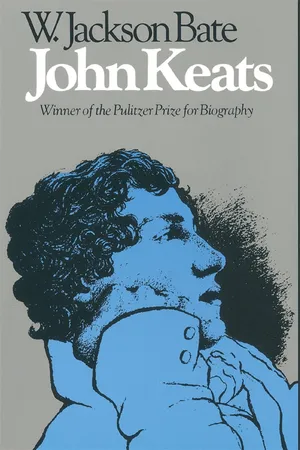John Keats
About this book
The life of Keats provides a unique opportunity for the study of literary greatness and of what permits or encourages its development. Its interest is deeply human and moral, in the most capacious sense of the words. In this authoritative biography—the first full-length life of Keats in almost forty years—the man and the poet are portrayed with rare insight and sympathy. In spite of a scarcity of factual data for his early years, the materials for Keats's life are nevertheless unusually full. Since most of his early poetry has survived, his artistic development can be observed more closely than is possible with most writers; and there are times during the period of his greatest creativity when his personal as well as his artistic life can be followed week by week.
The development of Keats's poetic craftsmanship proceeds simultaneously with the steady growth of qualities of mind and character. Walter Jackson Bate has been concerned to show the organic relationship between the poet's art and his larger, more broadly humane development. Keats's great personal appeal—his spontaneity, vigor, playfulness, and affection—are movingly recreated; at the same time, his valiant attempt to solve the problem faced by all modern poets when they attempt to achieve originality and amplitude in the presence of their great artistic heritage is perceptively presented.
In discussing this matter, Mr. Bate says, "The pressure of this anxiety and the variety of reactions to it constitute one of the great unexplored factors in the history of the arts since 1750. And in no major poet, near the beginning of the modern era, is this problem met more directly than it is in Keats. The way in which Keats was somehow able, after the age of twenty-two, to confront this dilemma, and to transcend it, has fascinated every major poet who has used the English language since Keats's death and also every major critic since the Victorian era."
Mr. Bate has availed himself of all new biographical materials, published and unpublished, and has used them selectively and without ostentation, concentrating on the things that were meaningful to Keats. Similarly, his discussions of the poetry are not buried beneath the controversies of previous critics. He approaches the poems freshly and directly, showing their relation to Keats's experience and emotions, to premises and values already explored in the biographical narrative. The result is a book of many dimensions, not a restricted critical or biographical study but a fully integrated whole.
Frequently asked questions
- Essential is ideal for learners and professionals who enjoy exploring a wide range of subjects. Access the Essential Library with 800,000+ trusted titles and best-sellers across business, personal growth, and the humanities. Includes unlimited reading time and Standard Read Aloud voice.
- Complete: Perfect for advanced learners and researchers needing full, unrestricted access. Unlock 1.4M+ books across hundreds of subjects, including academic and specialized titles. The Complete Plan also includes advanced features like Premium Read Aloud and Research Assistant.
Please note we cannot support devices running on iOS 13 and Android 7 or earlier. Learn more about using the app.
Information
Index

Table of contents
- Cover
- Title
- Copyright
- Dedication
- Preface
- Contents
- Illustration
- I. The First Years (1795–1810)
- II. Abbey’s Wards (1810–1815)
- III. Guy’s Hospital (1815–1816)
- IV. An Adventure in Hope (Summer 1816)
- V. The Commitment to Poetry: Chapman’s Homer, Hunt, and Haydon (Autumn 1816)
- VI. Completing the First Volume (November and December, 1816)
- VII. The Laurel Crown and the Vision of Greatness (December 1816 to March 1817)
- VIII. A Trial of Invention: Endymion
- IX. An Act of Will (June to December, 1817)
- X. Negative Capability
- XI. Another Beginning (December and January, 1817–18)
- XII. Devonshire and Isabella (February to April, 1818)
- XIII. The Burden of the Mystery: the Emergence of a Modern Poet (Spring 1818)
- XIV. The Departure of George Keats and the Scottish Tour (Summer 1818)
- XV. Reviews, the Writing of Hyperion, the Death of Tom Keats (Autumn 1818)
- XVI. Hyperion and a New Level of Writing
- XVII. Fanny Brawne; The Eve of St. Agnes (Winter 1818—19)
- XVIII. A Period of Uncertainty (February to April, 1819)
- XIX. The Odes of April and May, 1819
- XX. The Final Beginning: Lamia (May to July, 1819)
- XXI. The Close of the Fertile Year: “To Autumn” and The Fall of Hyperion (July to September, 1819)
- XXII. Illness (Autumn and Winter, 1819)
- XXIII. Adrift (January to August, 1820)
- XXIV. The Voyage to Italy (August to November, 1820)
- XXV. Rome and the Last Months (November 1820 to February 1821)
- Appendices
- Index
